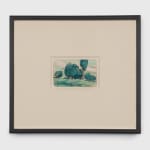Julio González
Though Julio González is best known for pioneering iron sculpture as a medium of radical abstraction, drawing remained a vital and continuous thread throughout his artistic life—a laboratory of ideas, a space of private vision, and a conceptual bridge between the pictorial and the sculptural. Trained in the fin-de-siècle atelier culture of Barcelona, and deeply influenced by the graphic poetics of Puvis de Chavannes and Edgar Degas, González was an indefatigable draftsman. He was rarely without a pencil or brush in hand, and his notebooks, many now dispersed, testify to a compulsive and lifelong engagement with line, gesture, and spatial notation.
His early works on paper, often rendered in watercolor, pastel, or ink, focused on scenes of domestic intimacy and femininity: women at their toilette, seated nudes, figures sleeping or ironing. Yet even in these early explorations, one sees González’s distinctive ability to use line not simply to describe but to construct—a sensibility that would later inform his groundbreaking contribution to the sculptural vocabulary of modernism.
The small drawing Les Saules (c. 1927), executed in pen, Indian ink, and gouache, offers a particularly evocative instance of González’s graphic sensibility during a transitional moment in his career. By this point, González had begun to conceive of sculpture as "drawing in space"—a radical idea that would culminate in his forged iron works of the 1930s. “In the disquietude of the night,” he wrote, “the stars seem to show us points of hope in the sky… It is these points in the infinite which are precursors of the new art: to draw in space.”
While Les Saules is, at first glance, far removed from the linear steel heads and abstract constructions of his mature sculptural phase, it nevertheless reveals a conceptual kinship. The trees—stylized into rounded, top-heavy forms rendered in cool blue and green washes—are outlined in fine black ink, suggesting both containment and movement. Their bulbous foliage hovers over slender brown trunks, which barely seem to anchor them to the land. The rhythmic tilting of the trees, paired with a series of fluid, calligraphic lines in the sky, evokes not just wind, but the sensation of flux, breath, and weightlessness. Here, the landscape is less a place than a vibration—a kind of melodic field, scored in line and tone.
The drawing dates from González’s return to more pictorial forms of expression after a long engagement with decorative and metalwork arts. Executed during the fertile period of the mid-to-late 1920s, Les Saules reflects both his modernist vocabulary and his regional affiliations. Though he would spend much of his adult life in Paris, González’s roots in Catalonia ran deep. The elegant orderliness of the composition, its economy of means, and its stylized clarity bear traces of Noucentisme—the Catalan cultural movement led by Joaquim Torres-García and Eugenio d’Ors, which advocated for classical restraint, civic virtue, and a rejection of avant-garde chaos in favor of Mediterranean balance.
While González never fully subscribed to the doctrinaire classicism of Noucentisme, the movement’s vision of nature as a locus of idealized harmony is clearly echoed in this drawing. One is reminded that Catalonia in the 1920s was a crucible of aesthetic and political ferment, where artists were engaged in forging a modernity rooted not in rupture, but in continuity—between classical ideals and modern form, regional identity and cosmopolitan ambition.
It is also worth noting the drawing’s physical intimacy. Punched holes suggest that it may have been part of a sketchbook or private folio, rather than a presentation work. This scale invites a kind of close looking—what the philosopher Gaston Bachelard might call “the reverie of the small.” The drawing offers no spectacle, no dramatic subject; instead, it rewards slow viewing, drawing the eye through the subtle variation of washes, the minor shifts in trunk angles, and the near-musical phrasing of the sky’s linear accents.
Though modest in size and subject, Les Saules captures a confluence of forces: González’s deep engagement with nature as a visual and emotional register; his sensitivity to the formal rhythms of line and wash; and his evolving understanding of how drawing could transcend the page and anticipate the open, spatial logic of sculpture. It is a drawing not simply of trees, but of structure, motion, and inner quiet—a lyrical notation of a world in suspension.
This drawing is inscribed by hand on the verso with title, dimensions, and reference FW624. It is also certified and signed by the artist’s daughter, Roberta González, on the verso.
M. Phillippe Grimminger has confirmed the authenticity of this work and it is accompanied by a certificate of authenticity issued by the Julio González Administration, Paris.
Provenance
Estate of Julio GonzálezPrivate collection, Barcelona
Private collection, New York
Literature
Josette Gibert, Julio González. Dessins: Catalogue Raisonné. Paysages. Paris: Editions Carmen Martinez, 1975, illustrated in black and white, p. 66.Tomàs Llorens Serra, Julio González: catálogo general razonado de las pinturas, esculturas y dibujos. Madrid: Fundación Azcona; Valencia: IVAM, Institut Valencia d'Art Modern, 2019, Vol. IV, cat. no. 2160, illustrated in black and white, p. 57.




